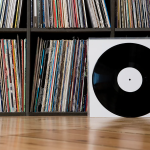Vinyl records have been spinning tales of audio fidelity and warm soundscapes for several generations. These grooved discs and their players are not just relics of the past but are cherished artifacts in the modern age. The allure of vinyl and the record players that bring them to life is not just about nostalgia; it’s about an appreciation for an audio experience that feels more tangible and authentic. This exploration will reveal the intriguing history, fun facts, and undeniable advantages of owning a record player in today’s digital world.
Introduction to Vinyl Records and Record Players
The musical journey on vinyl begins with a simple disc, traditionally made from polyvinyl chloride. It is an experience that engages multiple senses; the tactile feel of a record, the visual artwork on the sleeve, and the auditory pleasure of the music. Record players serve as the medium, translating the physical grooves on vinyl into the sounds that have defined countless moments in history. Vinyl records and their players offer an intimate connection to music that is often lost in the world of streaming and digital downloads.
Record players are not merely devices for sound reproduction. They are the heart of a vinyl system, providing not only the mechanics necessary to play the records but also contributing to the overall sonic signature of the music played. The components of a record player include the platter, which spins the record; the tonearm, which holds the stylus or needle; and the cartridge, which converts the movements of the stylus into electrical signals. Let’s delve into some fascinating vinyl records facts.
The continued interest in vinyl records and record players is a testament to their enduring appeal. The warmth and depth of analog sound, coupled with the ritualistic act of playing a record, provide a listening experience that is both immersive and personal. In a world where music is often consumed in a rush, vinyl records encourage one to slow down and truly listen.
A Brief History of Vinyl Records and the Invention of the Record Player
The tale of vinyl records began in the late 19th century, with the invention of the phonograph by Thomas Edison in 1877. The phonograph was revolutionary, using a needle to read vibrations from a cylinder and reproduce sound. However, it was Emile Berliner’s gramophone, which introduced flat discs instead of cylinders, that became the direct ancestor of modern record players. The gramophone’s discs were easier to produce, store, and offered better sound quality.
The progression from gramophone to modern record players witnessed numerous technological advancements. The introduction of the 33 1/3 RPM long-playing (LP) record in 1948 by Columbia Records and the 45 RPM single by RCA Victor revolutionized the music industry by increasing the amount of music a disc could hold. This innovation made albums viable and singles more accessible, broadening the music distribution model and changing the way people engaged with music.
Throughout the 20th century, record players became a staple in households. The 1960s and 1970s were considered the golden age of vinyl, with record players being the primary medium for music listening. However, with the advent of cassette tapes, compact discs, and eventually digital music, record players saw a decline in popularity. Despite this, they never disappeared completely, and the 21st century has seen a resurgence in vinyl appreciation, with record players once again becoming coveted items for music aficionados.
Fun Facts About Vinyl Records and Record Players
Delving into the world of vinyl records uncovers a treasure trove of intriguing tidbits. For instance, the largest vinyl record ever made was for the 2014 Winter Olympics in Sochi, which had a diameter of 50 feet and played the official anthem of the games. Additionally, the unique hiss, pop, and crackle sounds often heard during playback are due to dust particles and minor scratches on the vinyl surface, which some enthusiasts believe add character to the listening experience.
Another captivating fact is that vinyl records can be played at different speeds, typically 33 1/3, 45, or 78 revolutions per minute (RPM). Each speed correlates with a specific type of record. The 33 1/3 RPM is for LPs, the 45 RPM is generally for singles, and the 78 RPM was used for the earlier shellac records. The varying speeds are necessary to accommodate the amount of audio data etched onto the disc’s surface.
The artistry associated with vinyl is not limited to the music itself. Album covers are considered a form of artistic expression, often becoming iconic symbols in their own right. The cover of The Beatles’ “Sgt. Pepper’s Lonely Hearts Club Band” and Pink Floyd’s “The Dark Side of the Moon” are prime examples of album artwork that has transcended time and become cultural landmarks. Collectors often showcase their vinyl records like pieces of art, with the covers playing a significant role in the visual appeal of their collections.















